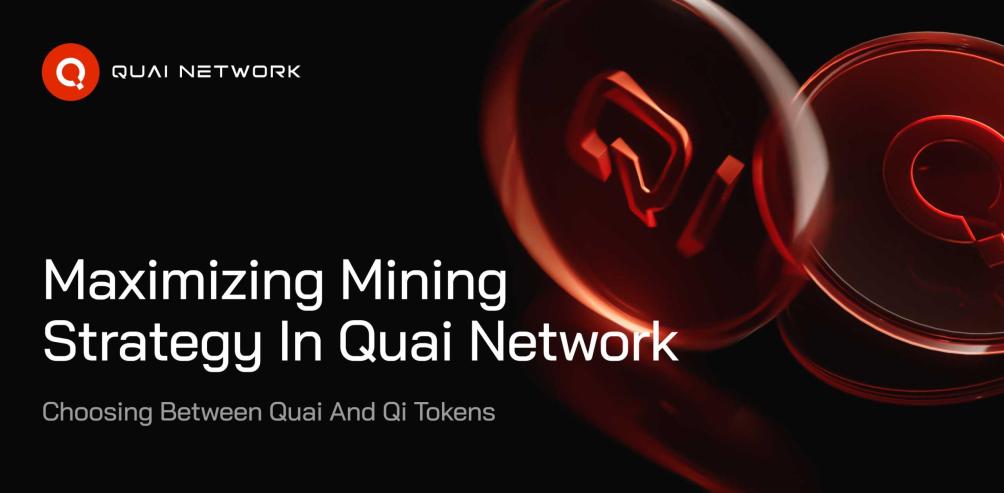
In Quai Network, miners have the unique opportunity to strategically choose between mining two tokens—Quai and Qi—each of which behaves differently in terms of emissions and mining difficulty. This flexibility offers a range of potential strategies for miners to optimize their earnings based on network conditions.
In this post, we’ll break down what this means for miners, how to set preferences, and strategies to maximize your holdings by balancing Quai and Qi. Let’s dive in!
Understanding Quai vs. Qi: Emission Rules
Qi emissions scale linearly with mining difficulty, meaning that as the difficulty to mine increases, the amount of Qi emitted increases at a constant rate.
Quai emissions, on the other hand, scale logarithmically with difficulty. This means as the difficulty to mine increases, the amount of Quai emitted per hash continually drops.Additionally, there is a conversion mechanism that allows miners and users to switch between Quai and Qi. The conversion rate adjusts based on the relative difficulty between mining Quai and Qi, providing an additional layer of strategy for those looking to maximize returns.
Why Should You Care?
As a miner, you have control over which token to mine and can adjust your mining strategy to favor Quai or Qi. This is done by modifying the miner preference setting in your configuration. By default, this setting is set to 0.5, meaning you’ll mine 50% Quai and 50% Qi.
However, you can adjust this setting to reflect your preference for one token over the other. For instance:
- Setting the value to 0 mines 100% Quai.
- Setting the value to 1 mines 100% Qi.
- A setting of 0.75 would result in 75% Qi and 25% Quai mined.
How Does Conversion Work?
The Quai Network allows users to convert between Quai and Qi through a dynamic conversion mechanism. The conversion rate between these two tokens changes based on several factors:
- Difficulty ratio between Quai and Qi.
- Emissions rates.
- Miner behavior and past conversion activities.
Active system participants can adopt a dynamic strategy for mining choice as well as converting between the two tokens. The basic strategy is as follows.
Basic Mining Strategy:
If you believe…
- Hashrate is “high” i.e. will decrease in the future:
- Choose to mine Qi
- Convert Quai to Qi
- Hashrate is “low” i.e. will increase in the future:
- Choose to mine Quai
- Convert Qi to Quai
This can be seen in the image below – the basic strategy.
To see expected return for utilizing this strategy, let’s look at the difficulty from Golden Age and show how profitable this can be.

Below is a graph in real time of a peak and valley in difficulty we will illustrate the strategy:
As you can see, the difficulty went from a peak of ~415 billion to ~344 billion. Following the strategy above you can calculate the relative emissions factor for Quai and Qi with the formulas below:

Quai was emitting ~1% more when the difficulty was higher, and Qi was emitting 20% more. Following the strategy above, if one were to convert Quai to Qi at the peak, switch mining to maximize the Qi relative to Quai on the way down, then convert back, to Quai, they could take advantage of the amount of Qi being emitted relative to Quai, and convert the Qi for more Quai then they started with at the peak. This is shown below.

Adjusting Miner Preferences: How to Do It
Changing your miner preference is a simple adjustment in your mining configuration. You can find a detailed guide on how to make this adjustment in our docs here. In the coming weeks, we’ll be introducing new tools to make this process even easier, allowing miners to change preferences without turning off their miners.
This will give you more flexibility to fine-tune your strategy as market conditions shift, ensuring you don’t miss out on the opportunity to optimize your returns.
Converting Between Quai and Qi: When and How?
At present, transactions in the network are paused, but on Wednesday, October 23, transactions will go live in Golden Age, enabling conversions between Quai and Qi.
With the upcoming release of the Pelagus wallet, users will be able to convert tokens directly and experiment with different strategies to grow their holdings. This feature will allow you to participate actively in the market and adjust your position depending on the emission rates, mining difficulty, and market sentiment.
To get started with Pelagus, you can download the wallet here and prepare to test out conversions once transactions are live.
Stay Ahead with Strategic Mining
In Quai Network, miners have the flexibility to craft a strategy that maximizes their holdings by adjusting their mining preferences and utilizing the conversion mechanism between Quai and Qi. By staying informed on hashrate trends and market conditions, you can make rational decisions on whether to mine Quai, Qi, or switch between them.
As always, keep an eye on network updates and difficulty trends, and stay tuned for new tools that will simplify preference adjustments and conversions.
Maximize your returns, adapt your strategy, and let’s build the future of decentralized mining together!
